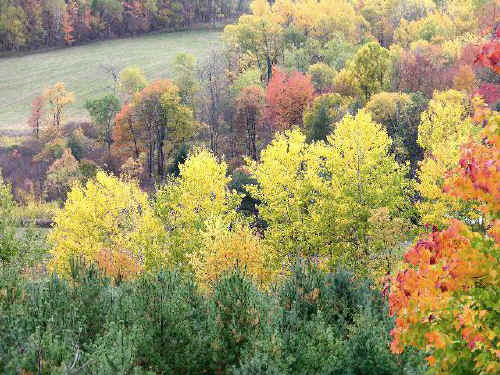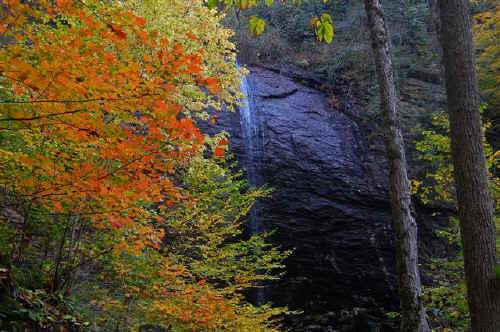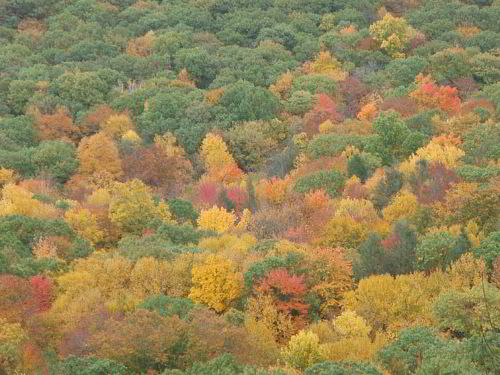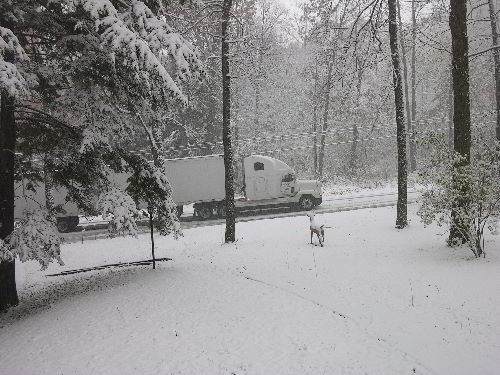|
==============================================================================
TOPIC: Fall colors and leaf drop
http://groups.google.com/group/entstrees/browse_thread/thread/05043c44cb820a96?hl=en
==============================================================================
== 1 of 3 ==
Date: Sun, Oct 26 2008 8:21 pm
From: Steve G
ENTS
Here in N Ohio, on October 26th, most oaks are still green, and many
other trees are just beginning to show fall colors and leaf drop.

Rocky River, Ohio Fall 2008. Photos by Steve Galehouse
Twenty years ago, tupelos would begin to color up in August; now
it's
in mid October. It seems "fall" has been pushed back at
least a month
from what it used to be. Any comments or observations?
Steve
== 2 of 3 ==
Date: Sun, Oct 26 2008 9:44 pm
From: "Edward Frank"

Near Reynoldsville, PA
Steve,
I haven't seen the same thing here in PA. I don't think the dates of
color are being pushed back in this region. I have been trying to
find a listing of dates of fall coloration on the internet for
periods in the past for comparison purposes, but have not had much
luck. In general the process really seems according to the
literature to be triggered by changes in day-length and not by
temperature changes. Therefore since the length of days have not
changed as a result of global warming, the dates of color change
should not have changed. I believe there is a difference in the
dates of color change and leaf drop from planted trees of a more
northern origin is earlier than those of local origin. I don't know
what to say about your experiences with the later coloration in your
area.
Ed
== 3 of 3 ==
Date: Mon, Oct 27 2008 12:57 am
From: James Parton
Steve,

Douglas Falls, NC - photo by James Parton
Here in WNC we are just past peak color. I visited Lowndesville SC
yesterday and the leaves there are just really beginning to turn.
They
are a little south of us and about 1300 feet lower in elevation.
James
October 28, 2008
Ed:
Because both temperature and day length control formation of fall
colors. Up here temperature used to be the primary controlling
factor (it got cold enough to cause leaves to change color and drop
before the days were short enough to do so), but now it doesn't get
as cold as early, so day length has more chance to cause the leaves
to change.
Lee
October 28, 2008
Lee and ENTS,
I guess my thoughts were ill-formed when I first posed the
question. What I am thinking is that there are two
mechanisms that cause the leaves to change colors and fall.
One is they are nipped by frost and drop. The other is that
they drop because the process is triggered by the change in
day length. One sort of backs up the other. If the
cold doesn't get them, then the leaf change goes to its fail-safe
option of change in day length. Why would the trees not
simply wait until cold caused the leaves to die off? Why
have this day-length mechanism at all?
There must be some disadvantage to allowing the leaves change and
drop to be triggered by temperature change, or some advantage to
the leaves being triggered by day length changes. What is
it? On the face of it, it would seem it would be best
overall for the trees to hang on as long as possible, to extend
the growing season, but the day-length trigger must have some
advantage that outweighs the gain from extending the growing
season at the cost of the leaves freezing. This must
be some specific ratio or formula balancing the benefits and
costs of both options. Why is the change at a specific
day-length? How specifically is this leaf change formula from day
length change determined? It may be different for
different species. Like now the black gum has long since
fallen (thin leaves), the maples are mostly down, but the oaks and
tuliptree leaves are still hanging on and to a large degree green.
Why is there this pattern, and why is color triggered by these day
length changes?
It is a genetic mechanism. Clonal colonies all seem to
change color at the same time. Trees transplanted from the
north change colors sooner than southern trees. Is the time
of nut production or fruit production triggered by the period
since leaf-out or also by a change in day length? That would
apply to blossoming in the spring - is it a certain time after
leaf out or set by temperature or set by day length? I know
blossoming can be delayed by weather, but what if the weather is
good? I am just trying to understand the processes
happening.
Ed
October 28, 2008

Closeup of the trees from the cliff at Rattlesnake Knob.
October 13, 2008- photos by Elisa Campbell
ENTS,
as New York state gets its first snow storm of the season - possibly
6-12 inches in the Catskills are predicated - it seems to me that
trees with leaves on them are severely impacted by heavy wet snow -
breaks many branches. So there would be a real advantage to losing
the leaves before snow is likely, I think.
Elisa Campbell
October 28, 2008
Ah, my favorite topic: leaf color change, abscission and dormancy
-
favorite because it is so beautiful and dramatic and our knowledge
is so
incomplete!
A couple of observations:
1 - dropping leaves is an active process and takes time; that is,
trees
form an abscission zone of dead corky cells at the base of the
petiole,
sealing off the xylem and phloem, then the leaves are able to fall,
sometimes in unison! I have come upon a ginkgo that has gone
golden
yellow, and then one morning, all leaves begin floating to the
ground,
in the absence of any wind, gently carpeting the space around the
tree,
leaving a stately naked skeleton with a golden skirt - as good as
any
Goldsworthy scuplture!
2 - trees that are frost nipped before they complete dormancy hang
on to
their leaves, until the petiole is frayed by the wind, or is pushed
off
in the spring by new leaves emerging - oaks often do this up here in
MA,
possibly because the day-length sensor is out of phase since they
are on
the northern edge of their distribution
3 - leaves that fall on their own, e.g. through dormancy and
abscission,
have very different nutrient contents than those that stay - so
resorption of nutrients may be one selective pressure for getting
the
job done before heavy frost shuts the whole process down.....the
counter
pressure is off course getting that last little bit of carbon fixed
into
starch - so trees gamble!
4 - color change is even more wonderful and mysterious - hypotheses
abound! but the reds (anthocyanins) definitely develop during
the
dormancy process and are not there before - at least in a colored
form -
they may take on color by being combined with sugars; and the
pattern of
color change is so different one species to another - sugar maples
show
a gradation in color that correlates with light intensity and/or
duration - I tell the students that trees are the first
photographers;
frequently you can pull away one very red/golden leaf to reveal an
outline of the that leaf in green on a leaf below it
5 - black gum leaves turn one at a time; green next to red,
apparently
NOT influenced by light - poplars keep a tuft of green leaves at the
very top of the tree until the very end
6 - and, sadly, flagging, or branches turning all red or yellow
before
the entire tree goes, can be a sign of disease or distress in that
section of the tree.
What fun.
Larry Winship
Larry,
Thank you. An excellent response that addressed my immediate
questions.
Ed
I guess that seeing the leaves of understory buckeye trees turn
yellow and drop during mid August is the one of the first obvious
indications that fall is on the way and it is one of the few color
changes of the year that will make my wife groan....she hates
winter!
Russ Richardson
October 28, 2008
Ed, ENTS-
Perhaps the timing of leaf coloring and drop can be thought of as
dependent on two main factors: 1). Day length, and 2). Environmental
stress.
Color due to reduced day length is obvious, but color due to stress
might be caused by: cold temperatures; increased daily temperature
fluctuation; drought; physical injury to tree; or insect/disease
infestations, and other factors I'm sure. I think we have all seen
the occasional tree in full fall color, but displaying the colors in
July or August, not October. This could not be caused by cold
temperatures, but rather indicates the tree is in some sort of
stress, and also shows that reduced day length alone is not the only
cause of fall color. I think in the area where I live the weather
patterns 20 to 30 years ago were such that the forest in
general was in a more stressed state in early autumn, and that
combined with day length created "earlier" falls, by about
two weeks.
As a separate comment, concerning intensity of fall colors
independent of timing, it seems like young trees typically display
brighter colors that mature trees, especially among oaks. Pin oak is
the commonest oak in my area, and mature trees, 2' or more in
diameter, usually turn from green to buff or just right to brown,
while saplings in the woods are often brilliant crimson red. The
white oaks and red oaks show the same pattern, with young,
vigorously growing trees producing the best fall colors.
Steve Galehouse
==============================================================================
TOPIC: Fall colors and leaf drop
http://groups.google.com/group/entstrees/browse_thread/thread/05043c44cb820a96?hl=en
==============================================================================
== 1 of 1 ==
Date: Tues, Oct 28 2008 8:14 pm
From: Randy Brown
Is it just my imagination or do old trees of a given species tend to
turn before the young ones?
== 2 of 9 ==
Date: Wed, Oct 29 2008 5:50 am
From: doug bidlack
That's just the opposite of what I observed this past weekend here
in southeastern MA. The scarlet oaks are starting to turn right now,
but it varies with size/age of the plant. Those that are no taller
than me are mostly brilliant red and those under 20' or so are maybe
halfway there. I've got this mental note that says scarlet oaks tend
to peak around the first weekend in November and I think that will
be fairly close for this year. As Steve noted, the larger, older
oaks don't seem to be very brilliantly colored. Every year I search
for a brilliantly colored very large scarlet oak and every year I
fail to find one even though these are among the most common upland
trees around here. This pattern doesn't seem to hold as well for
maples though. Even very large red and sugar maples are absolutely
beautiful in the fall. I do recall a sugar maple that I planted with
my parents in southeastern Michigan that did turn a brilliant orange
when it was
younger, but then settled into a lovely, but much less spectacular
yellow later in life. This tree later died and I wonder if it just
wasn't happy due to drought stress in the late 80's.
Doug
== 3 of 9 ==
Date: Wed, Oct 29 2008 8:43 am
From: "Edward Frank"
ENTS,
There has been a dramatic change in the weather here since
yesterday. Two days ago I was raking leaves in my yard. The black
gum and red maples are for the most part leafless. The tuliptree and
red and white oaks around the yard still are holding most of their
leaves. Yesterday was windy. Gusts were recorded nearby at 40 mph,
with a strong wind blowing almost continuously as the front passed.
A few good sized limbs blew down into the yard. Today I was awakened
by the sounds of tractor trailer trucks stuck on the hill in front
of my house. This is route 322 which parallels Interstate 80 across
much of Pennsylvania. Generally the big rigs travel I-80 unless
there is a problem on the interstate. The truck in the photo took
abut 1/2 and hour to inch up past the width of my yard. about twenty
minutes later it was backing down the hill.

The recent discussions on leaf color have been interesting and I
have learned a lot about the process. This had been one of the most
colorful fall foliage seasons in recent memory. I guess the absence
of cold-induced leaf mortality allowed the trees to turn colors
fully at the time controlled by day length. As Larry Winship says.
The leaves are gambling with their shut down mechanism. The
tuliptree and the oaks may have waited too long by the looks of the
snow outside, but the maples timed it about perfectly. I have
enjoyed the animated discussion of leaf color changes. The response
to my request for fall foliage photos has been excellent. I was
forced to downsize the photos posted on the fall 2008 foliage
webpage http://www.nativetreesociety.org/fall_foliage_2008.htm
simply because the number of images I received and posted to the
gallery. Some are simply fantastic.
Ed Frank
"Two roads diverged in a yellow wood, And sorry I could not
travel both. "
Robert Frost (1874-1963). Mountain Interval. 1920.
== 6 of 9 ==
Date: Wed, Oct 29 2008 3:12 pm
From: "Steve Galehouse"
ENTS-
As another point of interest regarding fall color and leaf drop, I
think it
is interesting that many, if not most trees of European origin
retain
foliage longer and color less vibrantly than native species. Norway,
hedge,
and sycamore maples are all still green in my area, as are English
oaks and
European beeches and hornbeams. The provenance of most of theses
species is
well north of the latitude of the U.S/Canadian border, so I'm not
sure how
that relates to the observation that (native) trees from more
northern
location lose leaves earlier than trees of the same species from
more
southern seed sources.These European trees seldom exhibit red or
orange fall
color, typically turning yellow or brown instead. It seems like
nearly all
trees or shrubs that display red or orange color are from eastern
North
America or eastern Asia.
Steve
== 7 of 9 ==
Date: Wed, Oct 29 2008 5:52 pm
From: "Edward Frank"
Steve,
That one I can address. It isn't strictly latitude, but the climate
of the region the tree come from. From farther north, I was meaning
farther north in North America. We are on the east side of a large
land mass and have a climate that is both much colder in the winter
and hotter in the summer than those in England and across much of
Europe. These areas are moderated by the expanse of the Atlantic
Ocean and the north sea. So trees from these area stay in leaf
longer, because they come from areas that do not get as frigid as
early in the year as it does here in the eastern US. The fall colors
here are supposed to be the best in the world, when we have a good
late frost, as we have had this year. Different species produce
different patterns of colors. I guess someplace has to be the most
colorful. Red and sugar maples are among the brightest colored of
the landscape dominating species.
Ed
"Two roads diverged in a yellow wood, And sorry I could not
travel both. "
Robert Frost (1874–1963). Mountain Interval. 1920.
== 9 of 9 ==
Date: Wed, Oct 29 2008 7:24 pm
From: "Steve Galehouse"
Ed, ENTS-
I know what you are saying--North America is "redder in tooth
and claw"
compared with Europe, as far as climate is concerned, and the autumn
display
of tree colors is much more vibrant here. My ten favorite species
for fall
display:
Tupelo
Sugar/Black maple
Red Maple
Sassafras
White ash
Tuliptree
Bitternut hickory
Serviceberry
Scarlet oak
Staghorn sumac
==============================================================================
TOPIC: Fall colors and leaf drop
http://groups.google.com/group/entstrees/browse_thread/thread/05043c44cb820a96?hl=en
==============================================================================
== 1 of 2 ==
Date: Thurs, Oct 30 2008 8:32 am
From: "Edward Frank"
Steve,
In this area of PA the woods have been cut over again and again.
Most of the trees are in the 80 year range in age. They are
dominated by red maple, various oaks, and birches - mostly yellow
birch. Other species are present, but in lower numbers.
I guess my
favorite must be red maple, because they have nice color and
basically that is how fall is supposed to look in my mind. There are
scattered black gum that give a burst of brilliant red. With the sun
shining on them or through they look fluorescent red in brilliance.
The birches provide a yellow back drop. I enjoy, unlike many people
the various subtle shades of tan and brown often shown by the oaks
as part of their fall display. Their reds and yellows aren't that
inspiring, but myriad tones of brown displayed has some quality that
appeals to me. The other tree species form little points of contrast
within this larger context. As I said before this has been a
memorable season for color in this area of Pennsylvania.
Ed Frank
== 2 of 2 ==
Date: Thurs, Oct 30 2008 1:35 pm
From: Andrew Joslin
This year's foliage display is so good that even the oaks are
looking
brighter than I can remember seeing. The colors are far from drab.
Scarlet and Pin Oaks are looking great and Red Oaks are showing a
variety
of color from a luminous warm yellow to some interesting burnished
shades
of red. Hickories (Pignut I think) are peaking bright yellow, a
great year
all around.
Andrew Joslin
Jamaica Plain, MA
|